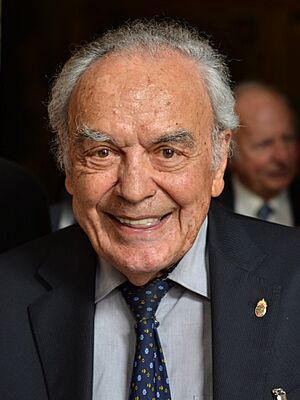Werner Arber facts for kids
Quick facts for kids
Werner Arber
|
|
|---|---|

Arber in 2018
|
|
| Born | 3 June 1929 Gränichen, Switzerland
|
| Education | Old Cantonal School Aarau ETH Zurich |
| Known for | restriction endonucleases |
| Children | Silvia Arber |
| Awards | 1978 Nobel Prize in Physiology or Medicine |
| Scientific career | |
| Fields | Microbiology |
| Institutions | University of Geneva, University of Basel, University of Southern California |
Werner Arber (born June 3, 1929) is a famous Swiss scientist. He is a microbiologist, which means he studies tiny living things like bacteria. He is also a geneticist, someone who studies genes and heredity.
In 1978, Werner Arber won the Nobel Prize in Physiology or Medicine. He shared this important award with two American scientists, Hamilton Smith and Daniel Nathans. They won for finding something called restriction endonucleases. These are like tiny scissors that can cut DNA at very specific spots. Their discovery was super important. It helped scientists create recombinant DNA technology. This technology lets scientists combine DNA from different sources. It's used in many areas, like making medicines and studying diseases.
Contents
Life and Discoveries
Werner Arber was born in Gränichen, Switzerland. He went to the Swiss Federal Institute of Technology in Zürich. There, he studied chemistry and physics from 1949 to 1953.
Early Research
In 1953, Arber started working at the University of Geneva. He began by using an electron microscope. Soon, he became very interested in bacteriophages. These are viruses that infect bacteria. He wrote his main paper about special types of lambda phages.
Arber explained how his research changed. He learned about experiments where phages moved genes between bacteria. This made him want to study these phages more closely. He worked with other scientists like Jean Weigle and Grete Kellenberger. This work was very successful. He said this was when he stopped being an electron microscopist. He became a molecular geneticist instead. This meant he studied genes and how they work at a tiny, molecular level.
Doctorate and Further Studies
Werner Arber earned his doctorate degree in 1958 from the University of Geneva. After that, he went to the University of Southern California. There, he studied phage genetics with Gio Bertani.
In 1959, he decided to return to Geneva. But first, he spent time at other famous laboratories. He visited labs at the University of California, Berkeley, Stanford University, and the Massachusetts Institute of Technology. These visits were very helpful for his research.
In 1963, while at Berkeley, Arber made an important discovery. He found the first evidence that bacteria like E. coli protect their own DNA. They do this by adding small chemical tags called methyl groups to their DNA. This process is called nucleotide methylation. This finding was a key step toward understanding restriction enzymes.
Return to Geneva and Basel
When Arber returned to the University of Geneva, he continued his important research. He worked in a lab in the Physics Institute. Many talented students and scientists joined him there. One of them was Daisy Roulland Dussoix. Her work was very important and helped Arber later win the Nobel Prize.
In 1965, the University of Geneva made him a special professor of Molecular Genetics. In 1971, Arber moved to the University of Basel. He was one of the first scientists to work in the new Biozentrum. This building was designed for different science fields to work together. It had departments for biophysics, biochemistry, microbiology, and more. This made it a great place for new discoveries.
Sharing Knowledge
Since 1981, Werner Arber has often shared his knowledge. He has attended the Lindau Nobel Laureate Meetings 27 times. At these meetings, Nobel Prize winners talk to young scientists.
Werner Arber is also a member of the Pontifical Academy of Sciences. He joined in 1981. This is a science academy connected to the Vatican. In 2011, Pope Benedict XVI made him the President of this academy. He was the first Protestant to hold this position. He retired from this role in 2017.
Personal Life
Werner Arber is married and has two daughters. One of his daughters, Silvia Arber, is also a well-known scientist.
Arber is a Christian. He believes that science and faith can go together. He has said that the idea of a Creator, or God, helps him understand how complex life began. He also feels that his belief guides him in difficult times. He sees it confirmed in the beauty of how the world works.
Images for kids
See also
 In Spanish: Werner Arber para niños
In Spanish: Werner Arber para niños

